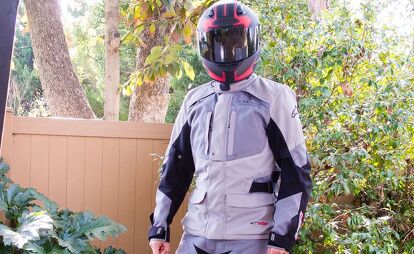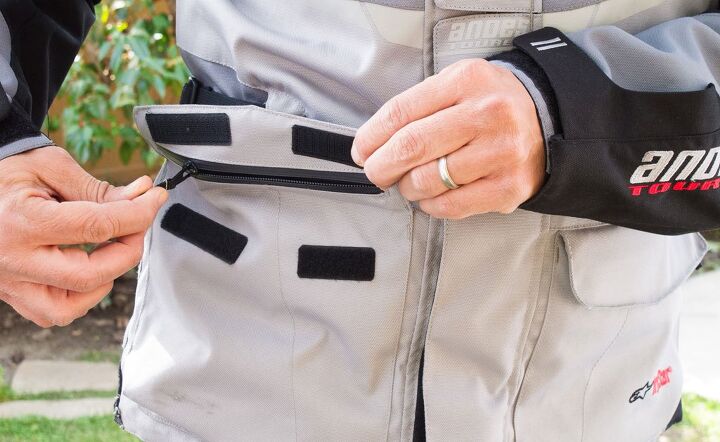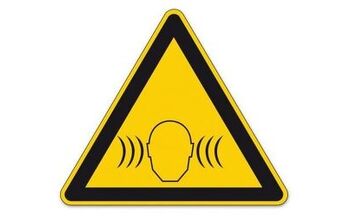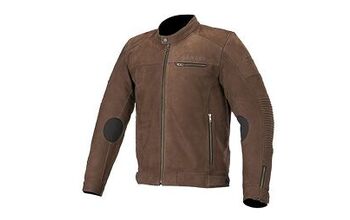Alpinestars Andes Drystar Jacket/Pants Review

Nicely priced waterproof gear, including a crash test!
Touring gear, by definition, must be versatile. If you’re traveling long distances, you’re likely to encounter a variety of weather conditions, perhaps even in the space of a single day. In addition, cargo carrying capacity is more important than on your typical day ride. Designed in the stylish adventure riding mold, the Andes is part of Alpinestars Tech-Touring line of gear.
Alpinestars Andes Jacket and Pants
| Aesthetics | 9.5/10 |
| Protection | 9.5/10 |
| Value | 8.5/10 |
| Comfort/Fit | 9/10 |
| Quality/Design | 9/10 |
| Weight | 9/10 |
| Options/Selection | 8/10 |
| Innovation | 8/10 |
| Weather Suitability | 8.5/10 |
| Desirable/Cool Factor | 9/10 |
| Overall Score | 88/100 |
Although the jacket and pants are sold separately, their features are almost identical, and most comments about the jacket apply to the pants. Any differences between the two will be noted.
The Andes apparel is constructed of a reinforced poly-fabric textile with a 600-denier rating, while waterproofness is delivered by Alpinestars’ Drystar breathable membrane. The jacket’s construction puts a 600-denier fabric shell on the outside with a waterproof liner permanently affixed to the inside. In practice, this feels a little like a removable jacket liner, but it is not. I assume this construction assists the jacket’s waterproofness by limiting the number of seams in the Drystar. If it were somehow attached to the inside of the shell fabric, every stitched seam created by pockets or protective panels would increase the potential points of leakage and require special sealing.
In dry weather, this dual construction allows the air to circulate between the two layers and draw moisture (remember the liner is breathable) and heat away through the two exit vents. You’ll never get the cooling as with a perforated jacket, but the two intake vents at the shoulders do a decent job of grabbing the wind blast and directing it between the jacket’s layers. Still, the jacket gets toastier than those equipped with Gore-Tex.
Product Review: Alpinestars 2014 Street Collection
The gauntlet on the jacket’s front zipper is divided into two pieces, allowing the top half to be snapped open for more cooling air to the rider’s chest. When closed, the flap creates a dam that prevents direct water access to the main zipper. The pants offer a zippered vent on the back of each thigh to extract moisture and heat, but there are no corresponding air intakes. Unfortunately, the Drystar membrane is not quite as breathable as Gore-Tex, which Alpinestars uses on its top of the line Tech-Touring gear.
The jacket’s sleeves and pants legs are pre-curved and offer accordion stretch panels to fit naturally without binding when in a riding position. Touring gear is designed to fit a bit on the loose side which allows maximum flexibility on what is worn underneath, and the Andes is no exception. The arms feature snaps to tighten the sleeves on the upper arms to keep the extra fabric from flapping. Generous wrist closures allow the sleeves to fit over waterproof gloves.
For colder weather, the Andes has removable thermal liners in the jacket and pants. On a recent ride where temperatures dropped down below freezing, my body was kept quite warm. This pairing has become my regular gear for winter rides.
Product Review: Joe Rocket Classic ’92 Jacket Review
The armor offered in the Andes lives up to Alpinestars’ reputation for building sturdy, protective gear. The rider’s bendy parts are covered by CE-certified Bio-Armor elbow, shoulder, and knee protectors. This foam-based armor is flexible enough to be comfortable and allow free movement while providing energy absorption on impact. The major impact areas on the elbows, arms and knees are the same 600-denier poly-fabric textile as the rest of the jacket but with, according to Alpinestars, a special “TPU (Thermo-plastic Polyurethane), in print texture form… applied to [these] critical wear areas to help protect the outer surface.” The Andes Drystar also receives printed reflective coatings that accentuate the style of the gear while providing important nighttime conspicuity.
The jacket also features two chest pockets and one back protector pocket that come with poly-foam padding. Optional Bio-Armor or Bionic protectors are available for those who want more protection. I opted for the $80 Bionic Air Back Insert with dual honeycomb construction for protection as well as ventilation. A Bio-Armor Back Protector will only set you back $30. Bionic Chest Pads can be added for $40, but no Bio-Armor option is available for the chest.
Daily use of the Andes points to Alpinestars’ well thought out approach to designing its gear. The jacket has tremendous cargo carrying capacity that ranges from easy to access but only water resistant to hard-core waterproofed storage. The two lower front hand pockets are zippered and covered with a storm flap to ensure watertightness. At chest level, two exterior and one interior pockets offer quick but only water resistant access to small items like your cell phone or wallet. The giant lower back pocket offers a convenient place to store things like the jacket’s liner. The liner itself has two small pockets. The Drystar shell has three Velcro-closed pockets for things that need to stay dry.
The Andes jacket and pants connect via a zippered waist panel that is elasticized for comfort. The jacket has a nylon belt that is D-ring adjustable while the pants use Velcro adjustments. The collar is lined with a soft fabric and features a cutout where it contacts the throat – something many jackets overlook. In fact, the only complaint I have with the jacket is the hook portion of the Velcro on the collar tends to grab the fabric cover of my helmet’s chin strap.
While the Andes jacket and pants proved comfortable in a variety of weather conditions, its utility is geared towards cooler to warm climates. Even with the venting, the jacket wouldn’t be ideal in really hot weather where you’d want airflow directly to the skin rather than between the jacket’s layers. Both the jacket and pants were perfect for riding in temperatures in to the upper 20s. The tunable fit of the jacket and pants allowed for comfortable, all-day riding as layers of clothing were added or removed.
Product Review: HJC IS-17 Helmet Review
The real test of riding gear, however, is how it behaves after we’re unceremoniously separated from our motorcycles. When a sheet of ice midway through a corner sent me to the pavement at about 35–40 mph, the Andes performed its duties admirably. Since I was carrying 25 lbs of camera gear on my back, I landed hard on my shoulder. The armor kept me from even getting a bruise although I did suffer mild shoulder ligament strain. I firmly believe that the armor absorbed enough of the impact to prevent additional injury.
The 600-denier shell showed scuffing and two small worn holes: one on the shoulder’s impact point, the other on the forearm. Both holes line up with the edge of the armor, illustrating the force they experienced in the crash. The pants also received scuffing and a small hole in the mid-thigh area, though not near any armor. I plan to have the holes patched and will continue to wear the Andes Drystar.
With a premium brand like Alpinestars, you may not expect a product in the value priced range, but the Andes Drystar jacket ($250) and pants ($230) offer exceptional styling and features at a reasonable price point in sizes S–4XL. Yes, the back protector does bump the price up a bit, but the final price is still significantly less than similarly equipped Gore-Tex waterproof gear. The color options are: black, black/yellow, and black/gray. Find out more at www.alpinestars.com.

Like most of the best happenings in his life, Evans stumbled into his motojournalism career. While on his way to a planned life in academia, he applied for a job at a motorcycle magazine, thinking he’d get the opportunity to write some freelance articles. Instead, he was offered a full-time job in which he discovered he could actually get paid to ride other people’s motorcycles – and he’s never looked back. Over the 25 years he’s been in the motorcycle industry, Evans has written two books, 101 Sportbike Performance Projects and How to Modify Your Metric Cruiser, and has ridden just about every production motorcycle manufactured. Evans has a deep love of motorcycles and believes they are a force for good in the world.
More by Evans Brasfield















































Comments
Join the conversation
The hole illustrates poor design. I've had similar lowsides at more or less the same speed (no camera gear though) and have had similar damage in jackets without heavy fabric overlays in these known impact areas. I won't buy a textile jacket without at least 1200 denier on the shoulder yoke and elbow/forearm, or leather since this is not a warm weather garment. Those jackets that sported this feature certainly scuffed (my 'fun' bike is an old Brit beater and both it and I have taken our share of beatings) but I've never gotten any holes. All my misadventures are around town so the speeds are 30ish or so. At highway speeds all bets are off. At the price point I think there are better designed garments, at least from a protection standpoint.